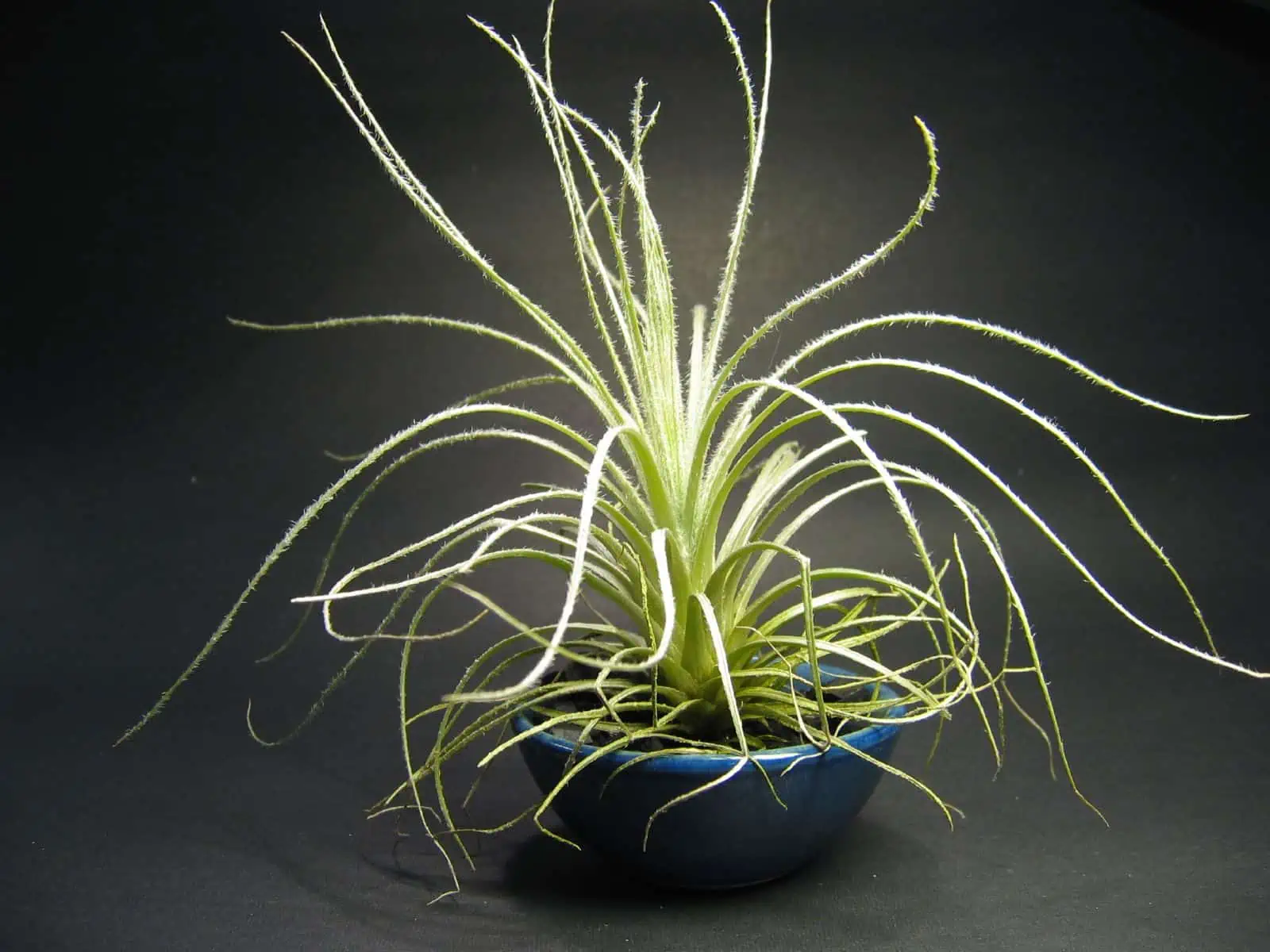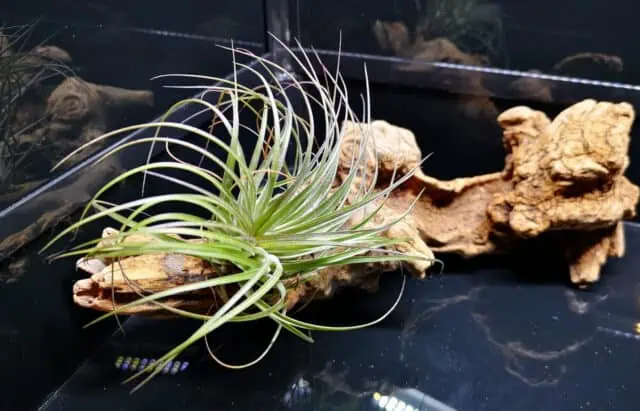Air plants are a top choice for leopard gecko tanks. They bring a touch of nature, versatility, and ease of care to the habitat. These unique plants, which grow without soil, are part of the Tillandsia genus. They offer various benefits to the environment of a leopard gecko, enhancing its overall well-being.
Air Plants in Leopard Gecko Tanks: Air plants, especially those from the Tillandsia genus, can enhance the environment of a leopard gecko tank, providing natural beauty and functional benefits such as shade and air filtration.
Watering and Misting: Regular hydration is crucial for air plants. Soak them for two hours every three weeks and mist lightly every couple of days to maintain optimal humidity.
Lighting Requirements: While leopard geckos don’t need intense light, air plants thrive in bright, indirect light. Ensure the plants are positioned in areas that receive filtered or diffused light within the tank.
Challenges to Watch For: Common issues include lack of moisture, inadequate lighting, and potential damage from the gecko’s activity. Regular misting, proper positioning, and protective barriers can help address these challenges.
What is an Air Plant?
An Air Plant, scientifically known as Tillandsia, stands distinct from traditional plants. One of its unique characteristics is its ability to thrive without being rooted in soil. Unlike most plants that absorb nutrients through roots, Air Plants do so through their leaves. These plants are part of the bromeliad family, specifically known as epiphytic plants. This means they can grow on other plants or surfaces, deriving their nutrients from the air, rain, or accumulated debris.
Another fascinating aspect of Air Plants is their versatility. They can adapt to various environments and don’t need soil to grow. This feature makes them different from most plants we commonly see. Their nutritional needs are also unique. Instead of relying on roots to draw nutrients from the soil, Air Plants extract what they need from the air around them.
There are various species of Air Plants, each with its own set of characteristics. For instance, Tillandsia ionantha is known for its vibrant colors and compact size, while Tillandsia caput medusae boasts an exotic appearance reminiscent of the mythical Medusa, with wavy tendrils extending outward. These species, along with many others, have varied growth rates and appearances, offering a diverse selection for enthusiasts.
Incorporating Air Plants into a Leopard Gecko tank can be beneficial. They not only add a touch of nature, making the environment more vibrant and appealing, but also offer functional benefits. Air Plants can provide shade, improve air quality, and create a natural-looking habitat, enhancing the overall experience for the gecko.
Benefits of an Air Plant in a Leopard Gecko Tank
Air plants bring numerous benefits when integrated into a leopard gecko tank. One of the primary advantages is the creation of a more natural environment. These plants mimic the gecko’s native habitat, making the tank feel more like home.
They not only enhance the aesthetic appeal but also provide functional perks. For instance, their leaves offer shade, a crucial element for geckos to hide and rest.
Moreover, air plants play a role in air filtration. They help in maintaining the quality of air inside the tank, ensuring it remains fresh and conducive for the gecko.
Maintaining air plants in a leopard gecko tank is relatively straightforward. Their easy maintenance nature means they don’t require constant attention. Watering and occasional misting are generally sufficient to keep them in good health.
They can seamlessly be incorporated into a bioactive setup. In such arrangements, all elements of the tank, from the substrate to the plants, work in harmony, replicating a natural ecosystem.
Types of Air Plants Suited For a Leopard Gecko Tank
With over 500 types of air plants available, choosing the right one for a leopard gecko tank can be overwhelming. While each species has its unique characteristics, certain ones are particularly well-suited for such environments.
Tillandsia Ionantha
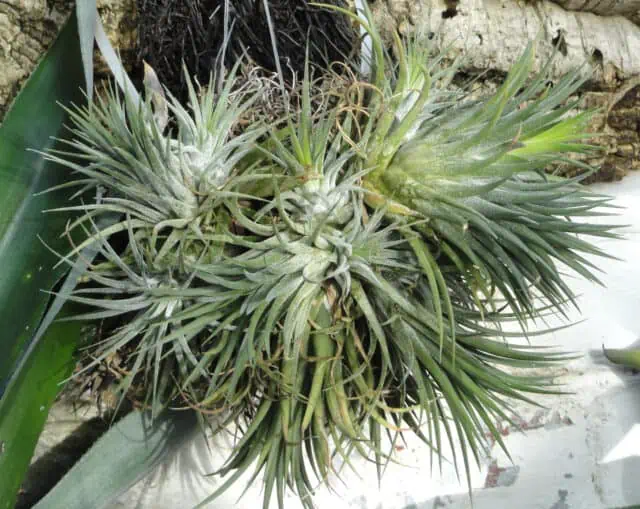
Tillandsia Ionantha is a popular choice for leopard gecko tanks. This air plant boasts vibrant colors that can transform the appearance of any tank, making it more visually appealing. One of the reasons it’s favored for gecko habitats is its low maintenance nature. Owners don’t need to dedicate extensive time or effort to its care, making it ideal for both novice and experienced keepers.
Furthermore, Tillandsia Ionantha thrives in warm temperatures, aligning well with the environmental needs of leopard geckos. This compatibility ensures that the plant remains healthy and vibrant within the tank. However, like most air plants, it does have specific water needs. Regular soaking in water every three weeks is essential to keep it hydrated and thriving.
Overall, its ease of care and adaptability make Tillandsia Ionantha a top pick for those looking to enhance their leopard gecko’s environment.
Tillandsia Caput-Medusae
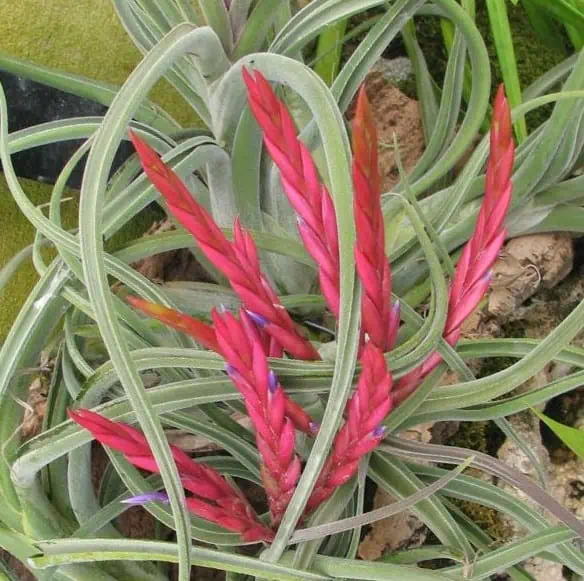
The Tillandsia Caput-Medusae is an intriguing air plant, known for its unique appearance that often draws comparisons to the serpentine locks of the mythical Medusa. Its long, wavy tendrils and distinctive growth habits set it apart from other air plant varieties. This captivating look can add a touch of natural beauty to any environment, making it a standout choice for a leopard gecko tank.
Beyond its aesthetics, Tillandsia Caput-Medusae is known for its hardiness. This robust nature means it can withstand various conditions, making it well-suited for a gecko habitat. It particularly thrives in bright and airy spots, so positioning it in a well-lit section of the tank can promote its health and growth.
In terms of care, Tillandsia Caput-Medusae has specific needs to keep in mind. Regular watering is essential, with a thorough soak recommended every couple of weeks. Additionally, ensuring good air circulation around the plant can help maintain its health and vibrant appearance. By catering to these requirements, owners can ensure that Tillandsia Caput-Medusae remains a flourishing and attractive addition to their leopard gecko tank.
Tillandsia Houston
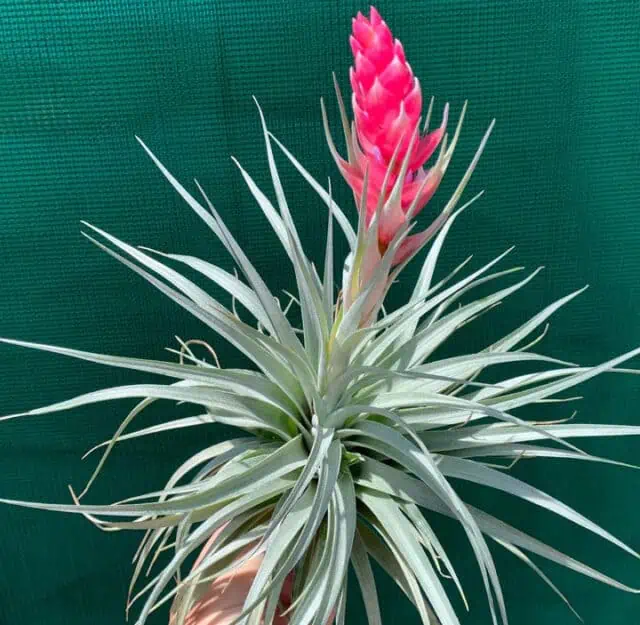
Tillandsia Houston stands as a remarkable member of the air plant family. This hybrid species, resulting from a cross between Tillandsia stricta and Tillandsia recurvifolia, showcases a rosette of silver-green leaves that can captivate any onlooker. Its form, combined with its vibrant bloom when flowering, makes it a sought-after choice for leopard gecko tanks.
Being an air plant, Tillandsia Houston is naturally adapted to terrarium environments. The controlled humidity and temperature within a leopard gecko tank align well with its natural habitat preferences. Moreover, it thrives in bright and airy spots, so placing it in an area of the tank that receives ample light can be beneficial for its growth.
Care requirements for Tillandsia Houston are straightforward but essential for its well-being. Regular watering is a must, with a deep soak advised every two weeks. Between these soakings, a light misting every few days can help maintain optimal moisture levels for the plant.
Tillandsia Tectorum
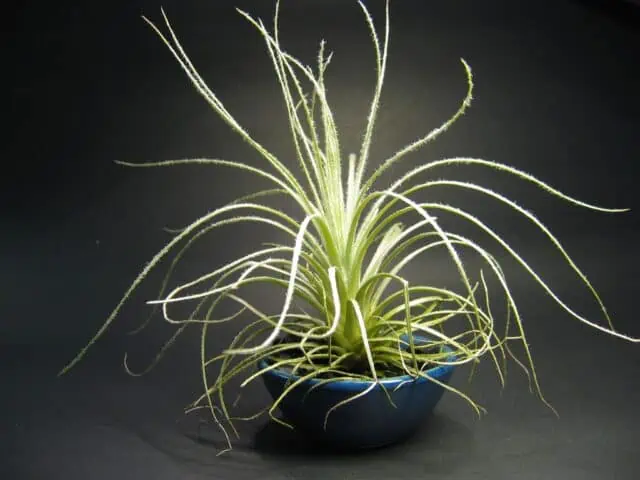
Tillandsia Tectorum is another remarkable air plant that fits seamlessly into a leopard gecko tank. Originating from the high-altitude regions of Ecuador and Peru, this air plant boasts a distinct appearance that sets it apart. It’s adorned with thick, fleshy leaves covered in a dense layer of trichomes, giving it a fuzzy, almost snow-like appearance.
This unique feature is an adaptation to its natural habitat in arid environments, where these trichomes help to capture and retain moisture from infrequent rainfalls.
When considering it for a leopard gecko tank, it’s essential to understand its care requirements. Tillandsia Tectorum prefers indirect light. Too much direct sunlight can harm the plant, so placing it in a shaded area of the tank or a spot with filtered light is recommended.
While it’s an air plant and doesn’t require traditional soil, if one chooses to place it in a substrate, ensuring well-draining soil is crucial. Overwatering or allowing it to sit in stagnant water can be detrimental.
How To Care For Air Plants
Caring for air plants in a leopard gecko tank requires understanding their unique needs. These plants, while versatile and adaptable, have specific maintenance requirements that differ from traditional plants.
As epiphytes, they don’t rely on soil for nutrients but absorb them through their leaves. This adaptation means their care routine is distinct and tailored to their unique biology.
Watering is crucial for air plants. A regular watering schedule is essential to keep them hydrated and healthy. It’s recommended to soak the plants in water for about two hours every three weeks. This deep soak ensures they absorb adequate moisture. Between these soaking sessions, a light misting every couple of days can help maintain optimal humidity levels, especially in drier environments.
Other key care requirements include lighting and air circulation. Air plants thrive in bright indirect light. While they can tolerate some direct sunlight, prolonged exposure can be harmful.
Positioning them in a spot that receives filtered or diffused light in the leopard gecko tank is ideal. Additionally, good air circulation is vital. It helps in the prevention of mold growth and ensures the plant dries adequately after watering or misting.
Common Challenges
Introducing air plants to a leopard gecko tank can present certain challenges. While these plants are versatile and adaptable, the environment within the tank, combined with the presence of the gecko, can lead to specific issues that need addressing.
One common challenge is the lack of moisture. Air plants thrive in environments where they can absorb moisture from the air. However, in a controlled habitat like a leopard gecko tank, humidity levels might not always be optimal. This can lead to the plants drying out, affecting their health and appearance.
Another issue is inadequate lighting. While leopard geckos don’t require intense lighting, air plants do need a certain amount of light to thrive. Balancing the light requirements of both the gecko and the plant can be tricky.
Additionally, the very inhabitants of the tank, the leopard geckos, might pose a challenge. These curious creatures might interact with the plants, potentially causing damage. The gecko’s activity can lead to uprooting or even tearing of the plants.
To overcome these challenges, here are some tips:
- Regular Misting: Ensure the plants are misted regularly to maintain the required moisture levels. This can help compensate for any lack of humidity within the tank.
- Positioning: Place the plants in areas that receive adequate indirect light. Using a light diffuser can help in ensuring the plants get the light they need without affecting the gecko.
- Protection: Consider using protective barriers or placing the plants in areas less accessible to the gecko. This can reduce the chances of the plants getting damaged.
As alternatives, there are many other plants that would do well in a leopard gecko tank. From succulents, to snake plants, and more.

